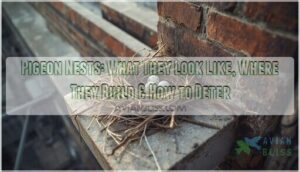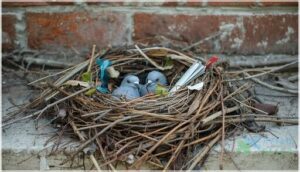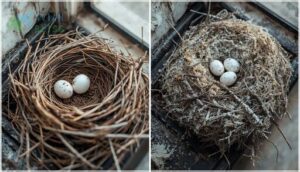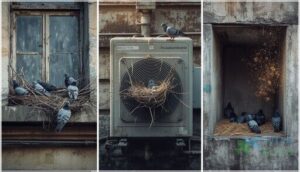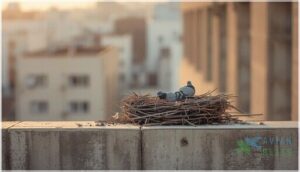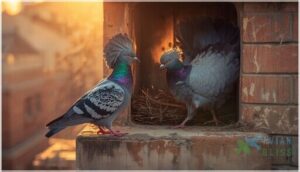This site is supported by our readers. We may earn a commission, at no cost to you, if you purchase through links.
Most people walk past pigeon nests a dozen times without ever noticing them. That’s because these birds don’t build the elaborate, woven masterpieces you might expect—they construct something closer to a haphazard pile of twigs that looks like it might blow away in a strong breeze.
Yet this seemingly careless approach works remarkably well for a species that breeds year-round and raises up to six broods annually. The simplicity isn’t laziness; it’s efficiency perfected over thousands of years of urban adaptation.
Whether you’re dealing with pigeons setting up shop on your balcony or you’re just curious about these ubiquitous city dwellers, understanding their nesting behavior reveals why they’re so successful at thriving alongside humans—and what you can do when that success becomes your problem.
Table Of Contents
- Key Takeaways
- What Does a Pigeon Nest Look Like?
- Where Do Pigeons Build Their Nests?
- Why Are Pigeon Nests So Simple?
- Pigeon Nesting and Breeding Habits
- Health Risks Linked to Pigeon Nests
- Effective Ways to Deter Pigeon Nesting
- Frequently Asked Questions (FAQs)
- What is a pigeon nest?
- What nesting materials are suitable for pigeons?
- Why do pigeons nest?
- How do pigeons make a nest?
- Why can’t pigeons build nests?
- Where do pigeons make their nests?
- What does a pigeon nest look like?
- Should I remove pigeon nest?
- Why don’t pigeons build nests?
- Where do pigeons make nests?
- Conclusion
Key Takeaways
- Pigeon nests look like haphazard piles of twigs because they’ve evolved for efficiency over aesthetics—these flat, 20-30 cm platforms let them breed up to six times yearly without wasting energy on elaborate construction.
- You’ll find these nests on ledges, balconies, and building features that mimic their ancestral cliff habitats, with urban pigeons thriving at densities over 2,000 birds per square kilometer in city centers.
- The real concern isn’t the messy nests themselves but the health risks and property damage from droppings, which can carry diseases like histoplasmosis and salmonella while corroding building materials over time.
- Legal nest removal requires careful timing since active nests with eggs are protected by wildlife laws in most regions, making prevention through physical barriers like spikes and netting your best long-term strategy.
What Does a Pigeon Nest Look Like?
If you’ve ever stumbled across what looks like a handful of sticks tossed carelessly on a ledge, you might’ve found a pigeon nest. These nests aren’t going to win any architecture awards—they’re famously simple, almost laughably so.
Let’s break down what you’re actually looking at when you spot one of these minimalist masterpieces.
Typical Materials Used
You’ll find most pigeon nests built from whatever’s close at hand—twigs and small branches form the backbone in about 87% of nests, while dry leaves, straw, and grass stems fill in the gaps.
In cities, these birds get creative with urban debris: plastic strips show up in 43% of nests, paper scraps in 34%, and you’ll even spot cloth, string, and packaging woven in.
The choice of nest material can be influenced by the availability of nest box materials that provide suitable microclimate conditions.
Nest Shape and Structure
Once you’ve spotted the twigs and scraps, you’ll notice pigeon nests are surprisingly flat—basically shallow platforms rather than the cozy cups most birds build. Here’s what makes their nest architecture unique:
- Platform design relies on loose twig arrangement for basic support
- Cup depth measures just 3–5 cm, barely enough to prevent eggs rolling
- Dish-shaped structure creates a flat internal surface for 1–2 eggs
- Minimal wall height distinguishes them from typical avian architecture
- Simple weaving allows pigeons to reuse and reinforce nests across breeding seasons
That’s why they look almost unfinished—nest stability comes from the ledge beneath, not elaborate nest building overhead.
Pigeons also demonstrate adaptability in their nest designs, showing an understanding of local climate conditions that influence their construction.
Size and Appearance
If you’re standing a few feet away, you’ll notice pigeon nests rarely exceed 23 cm in diameter when fresh—though multi-year nests can swell to 50 cm as droppings and debris accumulate.
| Nest Feature | New Nest | Multi-Year Nest |
|---|---|---|
| Diameter | 20–25 cm | 40–50 cm |
| Height/Depth | 3–6 cm | 15–18 cm |
| Appearance | Brown twigs, loose pile | Darkened, crusted layers |
Nest coloration darkens over time—fresh twig arrangement shows natural browns and grays, while older platforms develop white-streaked, hardened surfaces from repeated use.
Despite minimal structural integrity, these sparse platforms support two eggs and growing squabs season after season, proving that in avian architecture, less really can be more.
Where Do Pigeons Build Their Nests?
Pigeons are masters at adapting to wherever humans have built, which is why you’ll spot their nests in places that might surprise you. They don’t limit themselves to trees like many other birds—they’re just as happy on a window ledge or tucked behind an air conditioning unit.
Let’s look at the spots where pigeons usually set up camp, from bustling city structures to more natural hideaways.
Urban and Man-Made Structures
You’ll find pigeons thriving in cities because man-made features mimic their ancestral cliff habitats perfectly. Urban planning inadvertently creates ideal nesting sites throughout high-rise landscapes, with densities reaching over 2,000 birds per square kilometer in city centers.
These urban wildlife specialists favor:
- Balconies and window ledges on buildings of all heights
- Rooftops with sheltered eaves and overhangs
- Air conditioning units providing warmth and protection
- Parapet walls and concrete shelves on towers
- Vents and attic openings in older building design
Older structures built before 1936 particularly attract pigeons, as their rooftop habitats and architectural features offer countless spots for simple pigeon nests.
Natural Nesting Sites
Before cities existed, wild Rock Doves thrived on coastal cliff faces and inland gorges—their original homes. You’d spot nesting colonies tucked into rocky crevices along Scotland’s coasts, basalt cliffs in eastern Washington, and seaside ledges near open shrub vegetation.
These natural nesting sites provided the sheltered ledges and overhead cover that protected pigeon nests from wind and predators, setting the blueprint for today’s urban adaptations.
Preferred Nesting Locations
Urban pigeons zero in on balconies, window ledges, and facade niches that mimic their ancestral cliff faces. These roof structures and urban ledges offer the same overhead shelter and predator protection that wild Rock Doves once found in rocky crevices.
You’ll spot nesting sites on high-rise buildings up to 14 storeys tall, especially near food sources like markets or grain storage.
Why Are Pigeon Nests So Simple?
If you’ve ever spotted a pigeon nest and thought it looked like a toddler’s first attempt at architecture, you’re not alone. These birds get roasted online for their seemingly lazy construction skills, but there’s actually some clever reasoning behind the mess.
Let’s break down why pigeons build nests that look like they barely tried.
Nest Construction Process
Building a pigeon nest isn’t a marathon—it’s a quick team effort. The male gathers twigs, stems, and grasses over three to four days, while the female arranges each piece into a shallow platform with a small central hollow.
They work together in short morning and afternoon shifts, cementing everything with droppings. It’s efficient nesting at its finest.
Adaptations to Urban Environments
Concrete ledges have become the new cliff face for feral pigeons—you’re watching a master class in urban ecology. These urban wildlife conservation success stories showcase why pigeon nesting habits have been stripped down to basics:
- City habitats replace natural roosting sites with ready-made crevices and overhangs
- Nesting strategies shifted from elaborate structures to minimalist platforms
- Urban roosting on high-rises mimics ancestral cliff behavior
- Avian architecture favors energy efficiency over craftsmanship
- Urban pigeons maximize breeding by reusing existing shelter
It’s evolutionary brilliance disguised as laziness.
What looks like laziness is actually evolutionary brilliance adapted perfectly for city life
Comparison to Other Bird Nests
Think of a robin’s thick mud-walled cup or a weaver’s intricately woven pendant nest—that’s avian engineering at its finest. Pigeon nesting habits look downright lazy by comparison.
Their simple platform nest lacks the structural layers you’ll see in passerine nests, but here’s the kicker: this minimalist bird nest design actually works. Urban roosting pigeons trade complexity for efficiency, proving that in bird behavior and nesting strategies, simpler architecture can mean smarter adaptation.
Pigeon Nesting and Breeding Habits
Pigeons don’t follow the same breeding rulebook as most birds you’re familiar with. These adaptable city-dwellers can raise multiple broods throughout the year, forming surprisingly loyal partnerships that would put some romantic comedies to shame.
Let’s look at how their breeding timeline, courtship rituals, and parenting habits set them apart from their feathered neighbors.
Breeding Seasons and Frequency
Pigeons don’t wait for spring to get busy—they’ll breed practically year-round if conditions allow. You might spot active pigeon nesting in any month, though reproductive cycles peak from March through October.
Individual pairs can raise four to six broods annually, fledging rates that would make most birds jealous. This nonstop pigeon breeding means their nesting frequency stays surprisingly high, with new clutches starting roughly every 30 days under favorable circumstances.
Courtship and Pair Bonding
Once they’re ready to breed, pigeon courtship rituals kick in—males puff their chests, bow, and coo to catch a female’s attention. Pair formation happens quickly, and these birds commit.
You’ll find pigeons are surprisingly monogamous, often sticking with one mate for life. Bond strength is reinforced through billing (that beak-to-beak contact you might’ve seen) and mutual preening, behaviors that keep their connection solid across multiple breeding seasons.
Egg Laying and Incubation
After bonding, females lay 1–3 white eggs—usually 2—about 8–12 days after mating, with the second egg arriving roughly 24 hours later. Both parents share incubation duties for approximately 18 days, tag-teaming around the clock so eggs are almost never left alone.
- Pigeon eggs hatch after 17–19 days of incubation
- Pigeon chicks emerge helpless with sparse down and closed eyes
- Brood survival benefits from synchronized hatching between siblings
- Fledging rates remain high thanks to constant parental care and crop milk feeding
Health Risks Linked to Pigeon Nests
While pigeons might seem harmless, their nests and droppings can create real problems for your property and health. Understanding these risks helps you make informed decisions about managing pigeon activity around your home.
Let’s look at the three main concerns you should know about.
Property Damage From Droppings
You’ll want to know about the damage side of things. Those droppings aren’t just unsightly—their corrosive effects eat through stone, metal, and paint over time. Drainage issues crop up when nests block gutters, causing water damage.
Structural risks include ceiling collapse from accumulated waste. Cleaning costs add up fast, sometimes thousands per building.
Fire hazards emerge when nests obstruct vents, making bird pest control essential.
Disease Transmission and Allergies
Beyond the structural damage, you’re dealing with real public health risks. Fungal infections, airborne pathogens, and zoonotic diseases can stem from pigeon droppings and nesting debris. Here’s what matters:
- Histoplasmosis and cryptococcosis from disturbed droppings
- Salmonella detected in 20% of urban pigeons
- Psittacosis causing respiratory illness
- Allergic reactions triggering hypersensitivity pneumonitis
- Higher risks for immunocompromised individuals
Environmental hazards intensify when you sweep dry droppings without protection.
Legal Considerations for Nest Removal
Before you touch that nest, you need to know the law. In the UK, the Wildlife Countryside Act 1981 protects pigeons—nest removal without proper permits required can land you with fines up to £5,000 or jail time.
Lethal control demands proof of property damage and health risks, not just annoyance. Animal welfare rules apply even to “pest” species, so public health and safety claims must be documented.
Effective Ways to Deter Pigeon Nesting
If you’ve decided pigeons aren’t welcome on your property, you’ve got options—but timing and legality matter. The Wildlife & Countryside Act 1981 protects active nests, so you’ll need to act carefully or bring in someone who knows the rules.
Here’s how to discourage pigeons from setting up shop in the first place and keep them from coming back.
Professional Removal and Licensing
If you’re facing a serious pigeon problem, licensed pest control professionals bring the right tools and regulatory compliance to the table. Many states require wildlife management operators to hold specific credentials before handling pigeon nest removal, and professionals know how to navigate UK Wildlife Act protections or U.S. licensing requirements without legal headaches.
- Removal costs generally range from $300 to $2,000 depending on infestation severity
- Certified operators often need thousands of documented field hours plus exams
- Proper disposal of guano follows hazardous waste protocols with respirators and sealed bags
Physical Barriers and Deterrents
You’ll get the best results from a mix of bird spikes, netting systems, and visual deterrents like reflective Fire Flags. Bird spikes alone slashed pigeon numbers by 70% on treated buildings in one campus study, while properly installed netting creates near-100% exclusion in confined spaces.
Ledge guards angled at 45 degrees and surface barriers make roosting uncomfortable, turning your structure into a less-than-ideal pigeon hotel.
Preventing Future Nesting Problems
Once deterrents are up, you’ll want to seal roof gaps and vent openings with wire mesh—building reviews show this cuts pigeon re-entry by roughly 80%. Consistent sanitation and structural maintenance break nesting cycles far better than one-off fixes.
Lock down ongoing prevention with:
- Biannual roof and attic inspections to catch new activity early
- Daily waste removal and outdoor cleaning to eliminate food draws
- Professional service contracts for long-term monitoring and rapid response
Frequently Asked Questions (FAQs)
What is a pigeon nest?
Urban pigeons can produce up to 8 clutches per year, yet their nests look deceptively simple—just a flat, shallow platform of twigs, feathers, and droppings, usually measuring 20 to 30 cm across.
What nesting materials are suitable for pigeons?
Natural fibers like straw, hay, and coconut work best as pigeon nesting materials. Soft liners cushion eggs, while plant-based twigs provide structure. Eco-friendly options keep birds safe and comfortable without harmful chemicals.
Why do pigeons nest?
Like clockwork ticking through generations, pigeons nest because their breeding cycles demand it—up to eight broods yearly in cities.
You’re watching pure instinct meet urban adaptation, birds hardwired to reproduce wherever opportunity allows.
How do pigeons make a nest?
You might expect them to weave intricate structures, but pigeons simply gather twigs, leaves, and feathers into a loose pile.
Both parents collect materials, layering them into shallow platforms with minimal arrangement.
Why can’t pigeons build nests?
Pigeons absolutely can build nests—they’re just platform builders, not architects.
Their intelligence shines in problem-solving and memory, not elaborate weaving.
Urban Adaptations favor simple, efficient structures that work perfectly for their co-incubation strategy.
Where do pigeons make their nests?
You’ll find their nests on building ledges, rooftops, and balconies across cities—anywhere that mimics the cliff faces and rock crevices where their ancestors once nested before discovering urban roosting opportunities.
What does a pigeon nest look like?
Despite internet jokes, these structures aren’t lazy—they’re strategic.
You’ll spot a shallow platform of twigs, maybe twenty centimeters across, holding two white eggs on ledges that mimic ancestral cliff roosts perfectly.
Should I remove pigeon nest?
You shouldn’t remove a pigeon nest if it contains eggs or chicks—it’s illegal in most regions and can lead to fines.
Instead, explore humane deterrents and consult professional pest control services for safe removal.
Why don’t pigeons build nests?
You might be surprised to learn that 87% of pigeon nests contain just twigs and branches.
They actually do build nests—simple platforms that reflect clever urban adaptation and cooperative breeding strategies rather than laziness.
Where do pigeons make nests?
Pigeons select nesting sites mimicking their ancestral cliff habitats—ledges, balconies, bridge abutments, and rooftop spaces.
Urban roosts offer overhead shelter and stable footing, mirroring natural rock faces while staying close to food and water sources.
Conclusion
Regarding pigeon nests, what you see is what you get—a scraggly collection of twigs that somehow gets the job done. These birds have mastered the art of doing just enough to survive and thrive in our cities.
Now that you understand their nesting habits, health risks, and deterrent strategies, you’re equipped to reclaim your space without drama. Sometimes the simplest problems demand equally straightforward solutions.
- https://www.nssresearchjournal.com/ManageCurrentEditions/DownloadArticle/TM9Nvammtn9rQssk
- https://thinkindiaquarterly.org/index.php/think-india/article/download/19897/14722/
- https://www.allaboutbirds.org/guide/Rock_Pigeon/lifehistory
- https://www.xjenza.org/ISSUES/9/05.pdf
- https://ornitologia.org/mm/file/queoferim/divulgacio/publicacions/rco/rco_39_2023_4.pdf

